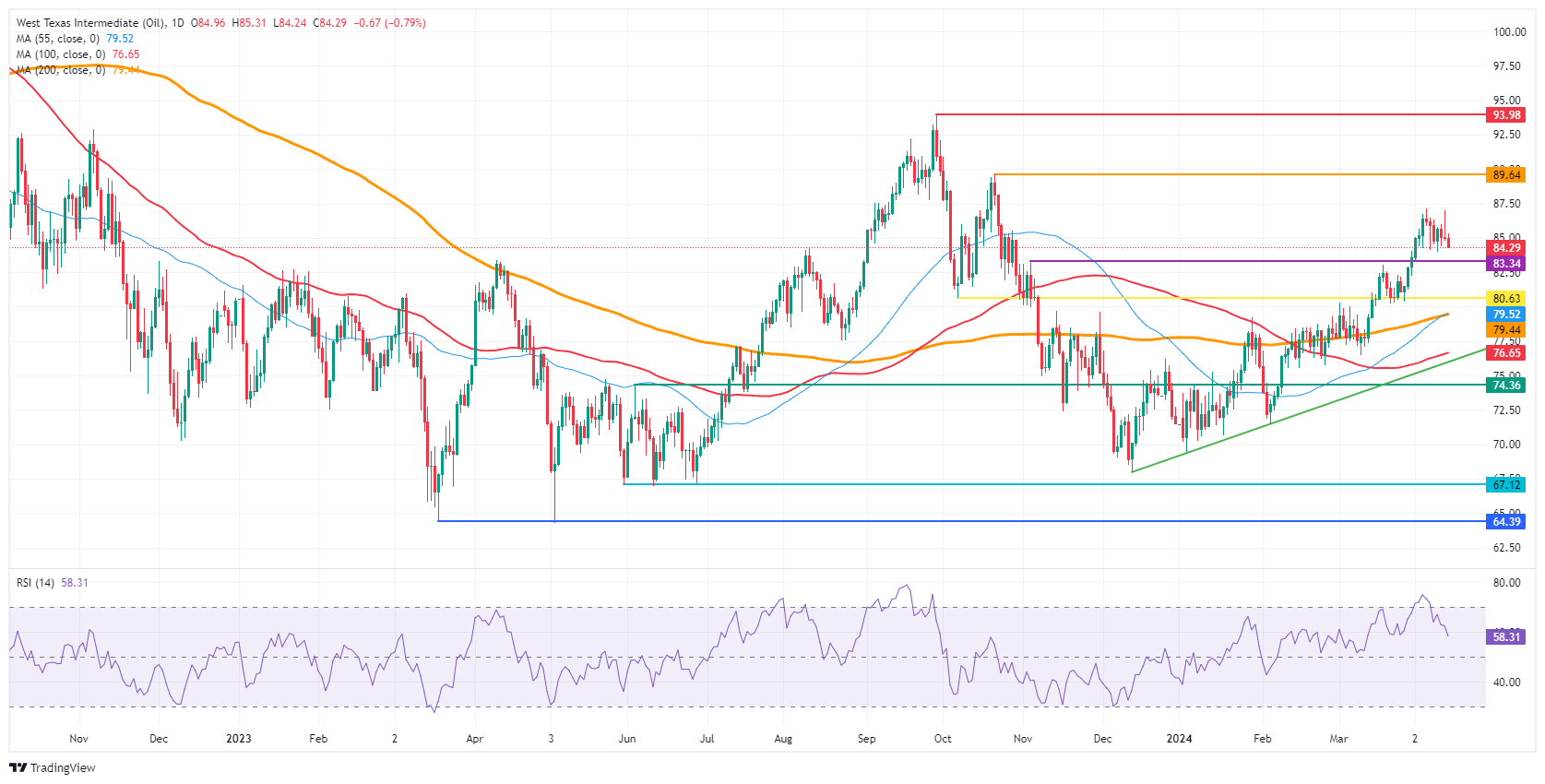- WTI oil falls below $85 after Iran's drone attack on Israel ended without massive effects.
- US Secretary of State Antony Blinken was speaking with several leaders in the region to ease tensions.
- The US Dollar Index declines below 106.00 as risk appetite over sentiment appears to be taking control.
Oil prices edged into a small discount on Monday after markets breathed a big sigh of relief following Iran's well-reported retaliation against Israel, which was well reported and caused very little damage, with investors hopeful that any escalation would result. contained. During the weekend, the attack occurred, consisting of an attack with drones and missiles, of which more than 99% was neutralized by the defense systems. Meanwhile, Iran has said it is not seeking a new escalation and even the US has already contacted Iran, meaning the diplomatic machinery is working to prevent a new escalation.
The US dollar, for its part, falls below 106.00. Global markets appear to be recovering, with all stocks rising, weighing on safe-haven assets like the US Dollar. Turning to the economic calendar, traders can prepare for Monday's US retail sales numbers.
Crude oil (WTI) is trading at $84.48 and Brent at $88.96 at the time of writing.
Oil news and market movements: the US and Iran want a de-escalation
- Daan Struyven, an analyst at Goldman Sachs, told Bloomberg that a risk premium of between $5 and $10 should be added to oil prices when the situation between Israel and Iran escalates.
- Iran already came out on Monday morning to say that it is not seeking a further escalation of tensions in the Middle East.
- Overall risk appetite is spreading across markets after tensions in the Middle East are easing.
- The upside risk to oil prices remains in the coming weeks in the event of oil embargoes against Iran, as the country is OPEC's third largest producer.
Oil technical analysis: Risk premium plummets
Oil prices fell on Monday after markets reduced the oil risk premium that had been priced in before the weekend. With investors applauding the de-escalation, a test towards $83.34 (purple line) is key. If the line is broken, further declines towards $80 are expected as the risk premium is discounted.
Should tensions escalate again and last week's high at $87.12 is broken, the $90 area should be within reach. A small barrier in the way is $89.64, the October 20 high. Should tensions intensify in the Middle East, it is possible that $94 could be reached, which could be a new 18-month high.
On the downside, $83.34 is the first level to watch after a very clean breakout and test of support on April 1-2. If not held, $80.63 is the next best candidate as a fundamental support level. A little softer, the convergence with the 55-day and 200-day SMA at $79.32 should stem any further decline.

WTI Crude Oil: Daily Chart
WTI Oil FAQ
What is WTI oil?
WTI oil is a type of crude oil that is sold in international markets. WTI stands for West Texas Intermediate, one of the three main types that include Brent and Dubai crude. WTI is also known as “light” and “sweet” for its relatively low gravity and sulfur content, respectively. It is considered a high-quality oil that is easily refined. It is sourced in the United States and distributed through the Cushing facility, considered “the pipeline junction of the world.” It is a benchmark for the oil market and the price of WTI is frequently quoted in the media.
What factors determine the price of WTI oil?
Like all assets, supply and demand are the main factors that determine the price of WTI oil. As such, global growth can be a driver of increased demand and vice versa in the case of weak global growth. Political instability, wars and sanctions can alter supply and impact prices. The decisions of OPEC, a group of large oil-producing countries, is another key price factor. The value of the US Dollar influences the price of WTI crude oil, as oil is primarily traded in US dollars, so a weaker Dollar can make oil more affordable and vice versa.
How do inventories influence the price of WTI oil?
Weekly oil inventory reports published by the American Petroleum Institute (API) and the Energy Information Agency (EIA) influence the price of WTI oil. Changes in inventories reflect the fluctuation of supply and demand. If the data shows a decline in inventories, it may indicate an increase in demand, which would drive up the price of oil. An increase in inventories can reflect an increase in supply, which drives down prices. The API report is published every Tuesday and the EIA report the next day. Their results are usually similar, with a difference of 1% between them 75% of the time. EIA data is considered more reliable since it is a government agency.
How does OPEC influence the price of WTI oil?
OPEC (Organization of the Petroleum Exporting Countries) is a group of 13 oil-producing nations that collectively decide member countries' production quotas at biannual meetings. Their decisions often influence WTI oil prices. When OPEC decides to reduce quotas, it can restrict supply and drive up oil prices. When OPEC increases production, the opposite effect occurs. OPEC+ is an expanded group that includes ten other non-OPEC member countries, including Russia.
Source: Fx Street
I am Joshua Winder, a senior-level journalist and editor at World Stock Market. I specialize in covering news related to the stock market and economic trends. With more than 8 years of experience in this field, I have become an expert in financial reporting.







